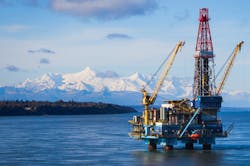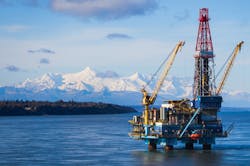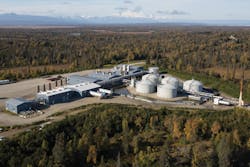North to Alaska
Miller Energy sells its long-time Tennessee assets to focus on Alaska operations
EDITOR'S NOTE: Miller Energy Resources, which is formally headquartered in Tennessee, recently opened an office in downtown Houston to take advantage of the city's energy expertise. The independent oil and gas producer sold its Appalachian assets in a deal that closed in November and is now totally focused on its operations in Alaska. OGFJ recently caught up with Scott Boruff, Miller's executive chairman, and Carl Giesler Jr., the company's new Houston-based CEO.
OIL & GAS FINANCIAL JOURNAL: We're visiting with Scott Boruff, the executive chairman and former CEO of Miller Energy Resources, and Carl Giesler Jr., the company's new CEO. Let's start with Scott. Tell us about Miller's energy assets.
SCOTT BORUFF: We have approximately 600,000 gross acres in four primary fields in Alaska. Three of those fields - the Redoubt, the West McArthur River, and North Folk - are located in the Cook Inlet area. The other field is an acquisition we announced last spring in the North Slope called Savant. About 62% of our reserves are high-value oil reserves, and we have a 100% working interest that allows us to control the pace of development and manage costs across our play. On top of all this, we also have the infrastructure in place to support significantly higher production volumes with the ability to maintain low operating costs. We believe that our midstream assets will be an important component of our growth story as we continue to increase production and grow our operations.
Targeting the Redoubt Shoals Field in the Cook Inlet area of Alaska is the The Osprey Platform.
Photo by Bryan Allen, PopFizz
OGFJ: Miller has grown a good bit recently. Fiscal 2014 in particular was a step-out year for Miller. What's driven the company's success?
BORUFF: Fiscal 2014 was a good year. Production, revenue, and adjusted EBITDA reached record levels. The reason is fairly straight-forward. We have a good asset base with substantial oil and gas resources and complementary midstream infrastructure. We also have assembled a good team behind those assets. A lot of work that we had been doing came together to drive the growth last year. There's inherent risk in our business, however, that we grapple with daily.
Photo by Bryan Allen, PopFizz
OGFJ: In the last year, Miller announced a sale of its Tennessee assets and has made two Alaska buys. These transactions have transformed your company's portfolio. Can you tell our readers what prompted the transactions?
BORUFF: It starts with our strategy - to become an attractive, simple way for investors to participate in the value of Alaska's substantial oil and gas resources.
The decision this past summer to sell our Tennessee oil and gas assets was tough. Tennessee is our home. Deloy Miller founded our company there and built it to become one of the largest operators in the state. We had solid assets there and many good, loyal employees. We think our buyer will have great success there.
At the same time, it was the right strategic move for us. We had built a significant oil and gas resource and infrastructure platform in Alaska. We needed to focus our management's time, as well as the market's attention, on that core aspect of our business. Our two most recent acquisitions - North Fork and Savant, which should close next month - both complement our existing Alaska assets quite nicely. North Fork gives us a lower-risk inventory of gas locations on the east side of the Cook Inlet. Savant gives us a strategic toe-hold on the North Slope.
OGFJ: Carl, what do you like about Alaska as a place to operate?
CARL GIESLER: We like to say we're in a "good neighborhood," arguably one of the best in the world to produce oil and gas. When you think about a neighborhood, you think about a lot of different things. You think about your neighbors, both the long-time ones and the new ones. You think about the value of your neighborhood and the potential for growth. And you probably think about the business environment and some of the leaders in the community. On all those elements, Alaska is a really great neighborhood.
Look at our neighbors. Both the long-time residents, such as mega-firms ExxonMobil and ConocoPhillips, as well as the newer ones, such as privately-held Hilcorp, private-equity backed Caelus, and super-independent Apache - are high-quality, well-respected, and smart.
Look at the growth potential. The majority of our resource base is undeveloped.
Look at the business environment and leaders. Not only do we have good rock in the state, we also have a good partner. In Alaska, the state and its leaders are very literally our partner. They have an active and constructive role in our - and every operators' - resource development planning and safety and environmental stewardship. Additionally, as incentive for companies like ours to develop the vast resources here, the state opens its wallet. Through cash tax credits, the state participates in as much as half or more of our drilling and completion investments. With this, Alaska isn't just helping us improve our returns, it is also helping us manage risk.
It's really win-win. Our shareholders and company get a motivated, aligned, all-in partner. The state gets accelerated resource development, more advanced technology, fuller employment, safer operations, and more responsible environmental stewardship. With Miller, the state benefits as well from direct public access to the Alaskan oil and gas markets for today's small-cap investor.
And, let's not forget, in addition to the business-friendly environment, Alaska offers premium pricing for both oil and gas. We sell our crude at ANS (Alaska North Slope) prices, which are very attractive [compared to Brent and WTI]. Similarly, our gas goes for $6 per Mcf or more compared to about $4 or less in the Lower 48.
All-in-all, we don't think you could ask for a better neighborhood in which to operate.
OGFJ: If Alaska is such a good neighborhood, why aren't more independent E&Ps there?
GIESLER: That's not entirely accurate. There are quite a few independent E&P operators in the state. The public companies tend to be on the very-large-cap side. But many E&Ps operating in Alaska are just not public. Take Hilcorp as an example. It is a highly successful E&P operator that recently made a huge investment by buying Alaska assets from Marathon and Chevron. But, Hilcorp happens to be private. Apollo, the private equity firm, also recently made a large investment in the Alaskan oil and gas markets through Caelus, its portfolio company which purchased Pioneer's assets in the state. But again, they're private. On the public side, besides us, the "smallest," if you can use that word, besides us, is Apache. While Apache is a significant player in Alaska, it also has substantial operations in other regions around the world. Their Alaska projects may not receive as much notice as a smaller-cap company like Miller Energy. In any event, we think our ability to provide access to the low-risk, high-reward projects in Alaska is a "win-win" for both small-cap institutional investors and Miller Energy Resources.
OGFJ: There's been a lot of talk about declining oil prices and the potential for an even further pullback. What impact do reduced oil prices have on your company's operations and planning process?
GIESLER: Like everyone else, we are keeping a very close eye on oil prices. We are focused on returns.
As we made clear at our annual meeting in late October, we're also adopting a much more measured approach related to drilling decisions in order to resume production and cash flow growth. While fiscal 2014 was a strong year for us with the drill-bit, fiscal 2015 has been more challenging.
To some extent, we have some cushion to absorb the recent oil price downdraft. Our operating costs average about $20 a barrel-equivalent. Also, we're well hedged with more than 90% of our production covered and meaningful hedges at $95-plus into our fiscal 2017. We're in an enviable position from a hedge standpoint. Additionally, we have attractive cash rebates and tax incentives offered by the state that other, non-Alaska producers don't have access to. These factors combined with the premium pricing we receive on both oil and gas should enable us to ride out any short-term decline in oil prices better than our non-Alaska peers.
OGFJ: Scott mentioned your midstream assets. Why are they an important component of your operations?
GIESLER: When you talk about midstream operations in Alaska, it's probably best to go into a little more detail on the Alaskan neighborhood. When you come to our neighborhood, you'll see that we live and operate in an area that's a little more remote. The geography and the more remote nature of Alaska make processing facilities and midstream assets even more important. Without midstream capacity, it's hard to grow. Our facilities still have substantial capacity.
In addition, when you look around the neighborhood, you'll also see some older, more dated processing facilities, kind of like looking at your neighborhood and observing the cars in the driveways. Many of our neighbors have what you would describe as 1960s pick-up trucks - trucks that are nice, but lack the modern sophisticated components of today's newer vehicles. They get fewer miles to the gallon, they're not as efficient, and they're probably a little more costly to operate.
At Miller Energy, in addition to various pipelines, we have two relatively new state-of-the-art processing facilities in the Cook Inlet area and in the North Slope area capable of processing more than 90,000 barrels of oil per day. The facilities are highly efficient, do not have high operating costs, and provide excellent returns. Don't get me wrong, I'm not saying we have a couple of 2015 Ferraris parked in our driveway, but when you look at them, they're probably pretty close to a couple of model year 2000 Ford F-150 pick-up trucks. And what's more, there's a positive impact that these facilities have on our operations. With these midstream assets we have been able to drive down costs. That's a huge benefit to our shareholders.
OGFJ: Any plans to MLP your midstream assets and take them public?
GIESLER: We're definitely evaluating it. The MLP construct - whether creating an MLP or partnering with an existing MLP - offers a cost of capital that is tough to beat. The timing isn't immediate, however. We need to ramp-up the utilization of our midstream assets. Regardless, our midstream assets are central to our value, and the MLP construct will likely remain as part of our go-forward strategy.
OGFJ: Can you talk to us about some of the management changes you've recently announced and how they are helping to facilitate your growth?
GIESLER:Recent changes in the management structure reflect a natural evolution of the company as we ramp-up to the next level. As you recall, one of our key strategies is to provide investors with access to lower-risk, higher-reward opportunities in the Alaskan oil and gas markets. The changing structure of our management team is helping us to focus on returns and drive value.
Let me give you an example. Scott is now executive chairman. In that role, Scott can focus on what he does best - help build the vision of the company. One of Scott's greatest talents is his ability to see what's around the corner. This talent enables him to grow our asset base and engage in strategic transactions.
Other changes at our board level have further strengthened our corporate governance policies. The improved corporate governance policies have increased transparency and are inviting greater investor participation in Miller Energy Resources' stock.
At the same time, our entire management team needs to focus on our core task of drilling productive wells as efficiently and safely as we can. And, we need to continue developing our processes to manage the risk in our operations and to ensure solid returns on the capital we deploy. Those efforts will be my primary focus.
BORUFF: To build on what Carl said, my focus will be less on the day-to-day and more on strategy and investor development. Those aspects have always been my strength.
The old axiom is true: In creating value, the price you buy is nine-times-out-of-nine more important than the price you sell. We've had good success with M&A in Alaska. Starting with our initial deal here with Pacific Energy's assets, continuing to our more recent North Fork and Savant deals, we've bought assets at their proved-producing and hard asset value or below. With Carl coming onboard [as CEO], I'll be focusing even more on JVs and other strategic deals that bring value to Miller.
Also, as the largest shareholder, I'm as aligned with investors as an executive can be. Making sure we're responsive to them and work for them is important to me.
OGFJ: Is there anything else you'd like to add?
BORUFF: In closing, I'd just like to say that we have a deep resource base and infrastructure platform and a strong team here at Miller Energy. Since our inception, we've worked hard and have grown from a small company producing approximately eight barrels of oil per day to a company that, with Savant, will produce close to 5,000 barrels per day. It's my belief, that with our Alaska resource base, the best opportunities for growth are yet to come.
Without question, Alaska is the best neighborhood in which to produce oil and natural gas. We view our investment in Alaska as a significant opportunity for Miller Energy as well as for institutional and small-cap investors seeking access to the productive Alaskan oil and gas markets.
OGFJ: Thank you both for your time today.
Anthony D. Andora contributed to this article. He is president of Edge Consulting, a communications and branding firm based in Los Angeles.



